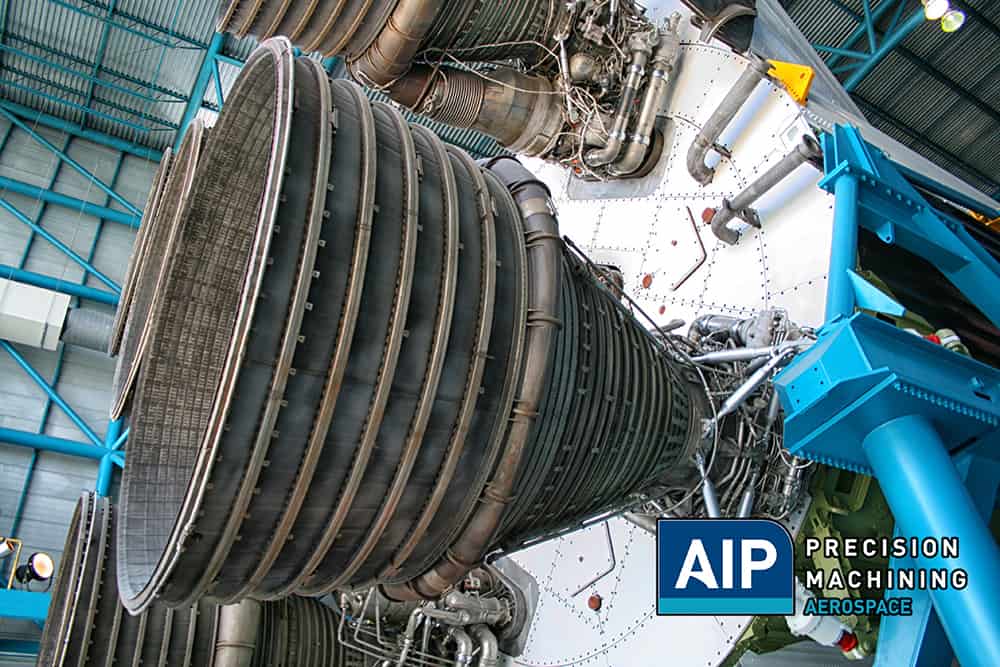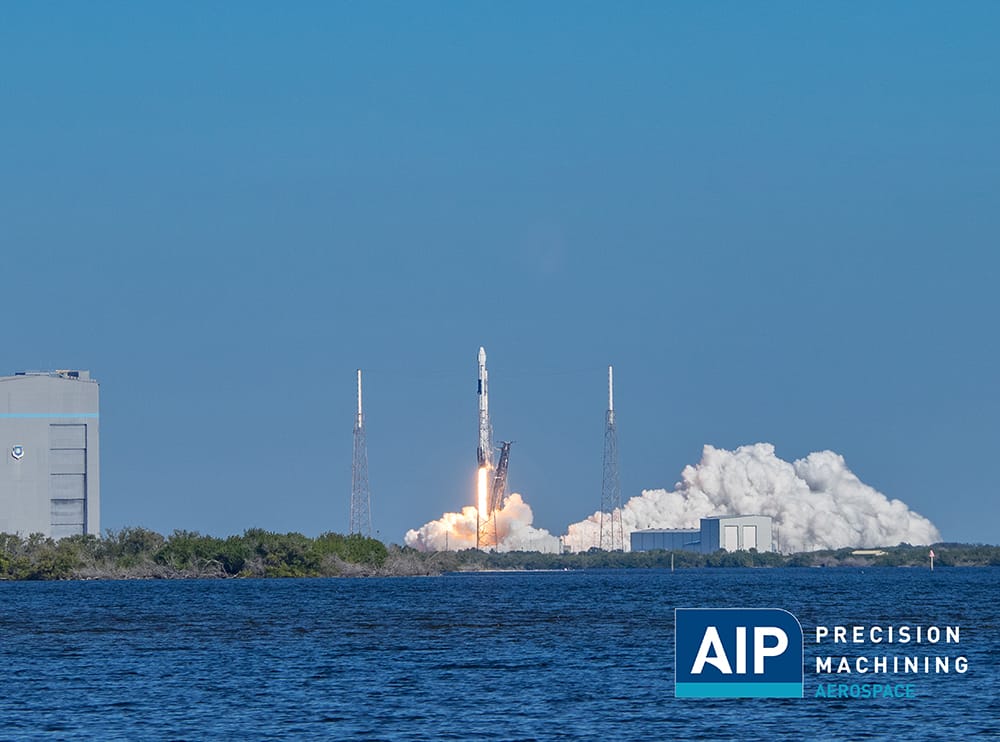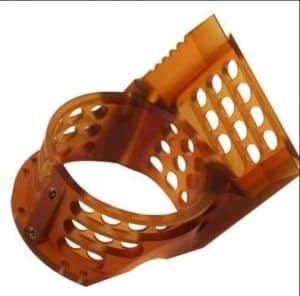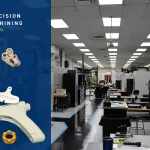
In the highly demanding conditions of space, the selection of materials used for spacecraft and associated systems are critical to mission success. The advent of advanced plastics, specifically high-temperature resistant polymers, has ushered in a new era of resilience and efficiency in the space industry.
These polymers, characterized by their exceptional performance under severe conditions, have proven to be indispensable in the design and construction of spacecraft components. In this informative brief from AIP Precision Machining, we explore the benefits of high-performance polymers, specifically their role in enhancing reliability, longevity and performance of spacecraft systems.
Critical Advantages of High-Performance Polymers in Demanding Spacecraft Applications
Employed in demanding spacecraft applications, plastics confer a multitude of tangible benefits. These materials exhibit low outgassing characteristics under vacuum conditions, an attribute critical for avoiding contamination in extreme outer space environments. They exhibit minimal friction, demonstrating significant life expectancy and diminished wear on interfacing metal components in vacuum, crucial for the overall durability and operational longevity of integral spacecraft apparatus.
Superior sealing capabilities, coupled with a consistent actuation torque when incorporated in spacecraft valves, affirm their practical utility in these complex mechanical systems. Inherent resistance to solvents, propellants, and other corrosive agents ensures their survival against the aggressive chemical milieu found in space. Moreover, these materials are resilient to radiation, sourced both internally and externally from the spacecraft, and exhibit noteworthy resistance to atomic oxygen-induced erosion.
 The temperature adaptability of these plastics is demonstrated by their operational reliability within the space environment, where temperatures range from -150°C to 130°C, and they exhibit resistance to elevated temperatures in rocket engine applications. Exhibiting optimal flammability characteristics, these materials are compatible with both liquid oxygen (LOX) and gaseous oxygen (GOX), critical for maintaining safety in the highly reactive environments of spacecraft.
The temperature adaptability of these plastics is demonstrated by their operational reliability within the space environment, where temperatures range from -150°C to 130°C, and they exhibit resistance to elevated temperatures in rocket engine applications. Exhibiting optimal flammability characteristics, these materials are compatible with both liquid oxygen (LOX) and gaseous oxygen (GOX), critical for maintaining safety in the highly reactive environments of spacecraft.
A key advantage of these plastics is their minimal moisture absorption prior to flight, a feature that preserves their structural and operational integrity. Additionally, they maintain excellent dimensional stability, exhibiting a low and consistent coefficient of thermal expansion.
These materials possess mechanical properties robust enough to withstand the extreme stresses associated with launch. Their lightweight nature, high specific strength and high specific modulus, contribute to the overall mass efficiency and increase payload capabilities of spacecraft. The excellent fatigue resistance of these materials, enabling them to withstand vibration and thermal cycling, is a vital aspect of spacecraft longevity.
Electrical insulation is another key application for these materials, which exhibit high dielectric strength, low dielectric constant, and low dissipation factor across a wide range of temperatures and frequencies. This is important when these materials are used for spacecraft antenna radomes. Their low thermal conductivity makes them apt choices for thermal insulation applications. Further, these materials possess vibration-damping characteristics, a critical requirement for safeguarding sensitive optics and electronics onboard spacecraft.
Types of High-Performance Polymers Used on Spacecraft Applications

The space environment presents a myriad of challenges that place considerable demands on the materials used in spacecraft. To meet these requirements, it’s crucial to turn to materials that offer superior performance characteristics. High-performance plastics stand at the forefront of this revolution, providing a unique blend of properties such as exceptional thermal resistance, chemical resilience, and structural integrity.
Let’s delve into the advantages of three high-performance plastics— ULTEM®, TORLON®, and VESPEL®—including their properties, benefits, and common applications. Each of these materials brings a unique set of benefits for aerospace applications, and understanding these nuances is key to harnessing their full potential.
Ultem:
Ultem®, an amorphous thermoplastic polyetherimide (PEI) resin, is renowned for its exceptional thermal resistance, dielectric strength, stiffness, and good chemical resistance, making it a material pick for various space and rocket propulsion systems applications.
 Ultem’s notable characteristics are high processability, dimensional stability, environmental stress resistance, and flammability resistance, all of which are critical for the harsh and unpredictable conditions of space. It also offers long-term heat resistance, which is a significant factor for components exposed to extreme temperatures, which is beneficial for rocket launches.
Ultem’s notable characteristics are high processability, dimensional stability, environmental stress resistance, and flammability resistance, all of which are critical for the harsh and unpredictable conditions of space. It also offers long-term heat resistance, which is a significant factor for components exposed to extreme temperatures, which is beneficial for rocket launches.
Ultem’s elevated tensile strength of 15,200psi and consistent performance up to 340ºF underline its suitability for high-strength applications in the space industry. Its long-term creep resistance ensures the material does not deform under long-term mechanical stress. This makes it an excellent substitute for metal in many structural applications of spacecraft and rockets. The inherent flame resistance, chemical and hydrolysis resistance, and one of the highest dielectric strengths (830 V/mil ASTM D194) among thermoplastics are additional advantages that Ultem provides.
This material’s unique processability and dimensional stability, combined with its mechanical properties, provide considerable flexibility and freedom to design engineers. As a result, Ultem can be used in diverse components, including electrical insulators and parts of the propulsion system that require high strength and heat resistance.
Ultem’s versatility also extends to underwater connector bodies, an essential aspect in certain space missions that involve water landing of spacecraft. Furthermore, its unique dielectric properties make it suitable for analytical instrumentation and semiconductor process components found in spacecraft and satellites.
In summary, Ultem, with its balanced mechanical properties and processability, offers unique solutions to the space research industry’s demanding requirements. It is a premier high-temperature resistant polymer in the design and construction of spacecraft, rocket propulsion systems, and satellites.
|
PROPERTIES |
COMMON USES |
| ● Dimensional Stability
● Environmental Stress Resistance ● Flammability Resistance ● High Processability ● High Stiffness ● High Strength ● Long-Term Heat Resistance ● Smoke Generation Resistance ● Toxicity Resistance |
● Analytical Instrumentation
● Dielectric Properties Required ● Electrical Insulators ● High Strength Applications ● Reusable Medical Devices ● Semiconductor Process Components ● Structural Components ● Underwater Connector Bodies
|
Torlon®:
Torlon®, Polyamide-Imide (PAI) resin, is one of the highest-performing, melt-processible plastics. Due to its ability to retain strength and stiffness up to 500°F (260°C), its excellent wear resistance, and ability to endure severe thermal, chemical, and stress conditions, Torlon finds its place in many critical applications within space and rocket propulsion systems.
Several grades of Torlon are available, each with specific use cases. These include Torlon® 4203 (primarily for electrical and high-strength applications), Torlon® 4301 (general-purpose wear), Torlon® 4XG (glass-reinforced), and Torlon® 4XCF (carbon-reinforced). These varieties allow for a wide range of applications based on specific needs within the space industry.
See the Specs → Discover Torlon’s Grades for Aerospace Applications
One of the notable characteristics of Torlon PAI is its high compressive strength, which is double that of PEEK and about 30% higher than Ultem PEI. This impressive strength, paired with the highest tensile strength of any unreinforced thermoplastic (21,000 psi), ensures that Torlon-based components can withstand the extreme mechanical stresses during a rocket launch and space travel.
 Torlon also offers excellent wear and radiation resistance, both of which are essential properties for materials used in space environments. Inherent low flammability and smoke emission make it an ideal material for high temperature and potentially hazardous conditions present in rocket propulsion systems.
Torlon also offers excellent wear and radiation resistance, both of which are essential properties for materials used in space environments. Inherent low flammability and smoke emission make it an ideal material for high temperature and potentially hazardous conditions present in rocket propulsion systems.
Torlon’s extremely low thermal expansion and superior creep resistance make it an excellent choice for tight-tolerance applications. This is especially useful in space applications where maintaining precise dimensional tolerances is crucial for system reliability and efficiency.
Structural parts of spacecraft and rocket propulsion systems are areas where Torlon is extensively used, as these parts must resist the high temperature and intense stress conditions of space travel. High-temperature electrical connectors, a critical component for successful signal transmission and data collection in spacecraft and satellites, can also benefit from the use of Torlon due to its excellent thermal resistance and high strength.
Moreover, Torlon’s excellent wear resistance and strength make it suitable for wear rings and valve seats in rocket engines, contributing to the longevity and efficiency of propulsion systems. It’s also used in bearing cages that support the rotation of mechanical parts, aiding in the smooth operation of various systems within the spacecraft.
However, Torlon’s moisture absorption rate, while not as low as other high-performance plastics, should be taken into account when designing components for use in humid environments. This consideration is essential to ensure the longevity and performance of Torlon-based parts in all space missions.
Overall, Torlon, with its excellent thermal, chemical, and stress resistance, coupled with high strength and stiffness, offers significant advantages in the design and construction of spacecraft, rocket propulsion systems, and satellites, thus playing a critical role in the space industry’s advancements.
|
PROPERTIES |
COMMON USES |
| ● Excellent Chemical Resistance
● Excellent Stress Resistance ● Excellent Thermal Resistance ● Excellent Wear Resistance ● High Stiffness ● High Strength |
● Bearing Cages
● High-Temperature Electrical Connectors ● Structural Parts ● Valve Seats ● Wear Rings ● Seals |
Vespel®:
The high-performance polyimide resin Vespel® is a well-known name in the aerospace, semiconductor, and transportation technology industries. It is highly valued for its combination of heat resistance, lubricity, dimensional stability, chemical resistance, and creep resistance. This balance of properties makes it particularly suitable for use in extreme and hostile environmental conditions, such as those encountered in space.
 One of the remarkable characteristics of Vespel is its high-temperature resistance. This makes it ideal for use in the space industry where materials are frequently subjected to extreme temperatures. Furthermore, Vespel does not exhibit significant outgassing, even at high temperatures. This makes it useful for manufacturing lightweight heat shields and crucible support structures for spacecraft and rocket propulsion systems, where any outgassing could cause contamination and performance issues.
One of the remarkable characteristics of Vespel is its high-temperature resistance. This makes it ideal for use in the space industry where materials are frequently subjected to extreme temperatures. Furthermore, Vespel does not exhibit significant outgassing, even at high temperatures. This makes it useful for manufacturing lightweight heat shields and crucible support structures for spacecraft and rocket propulsion systems, where any outgassing could cause contamination and performance issues.
Vespel’s outstanding strength and impact resistance combined with low wear rates also contribute to its broad use in the space industry. Rocket propulsion systems and satellites need materials that can withstand extreme conditions while maintaining their mechanical properties. With its ability to retain mechanical properties at very high temperatures (up to 500ºF), Vespel serves as an excellent candidate for these systems.
Vespel’s high resistance to chemical corrosion makes it a suitable choice for parts that might come into contact with various industrial hydraulic fluids, fuels, and solvents during the spacecraft and satellite operations. This chemical resistance contributes to the longevity and reliability of the systems where Vespel is used. The chart below shows a breakdown of Vespel’s chemical resistance to common industrial fluids:
| Chemical Media | F | K | Time Hrs. |
% Tensile Strength Retained by SP-1 |
| Industrial Fluids | ||||
| Hydraulic Fluid | 248 | 393 | 1000 | 100 |
| JP-4 Jet Fuel | 210 | 372 | 1900 | 80 |
| Jet Engine Oils | 500 | 533 | 600 | 60 (90)(2) |
| Mineral Oil | 392 | 473 | 1000 | 70 (90)(2) |
| Silicone Fluid | 500 | 533 | 1000 | 70 (85)(2) |
| Ticresyl Phosphate (oil additive) | 500 | 533 | 1000 | 80 |
In vacuum applications and extremely low cryogenic temperatures, Vespel performs exceptionally well, which is crucial for many space applications. Vespel’s ability to perform from cryogenic to extremely high temperatures results in a great seat or seal material for propulsion fuel systems. Despite absorbing a small amount of water that can lead to longer pump times in a vacuum, its overall performance in vacuum environments is commendable.
The ease with which Vespel can be machined to achieve complex geometries and tight tolerances offers great flexibility to design engineers. This allows for the creation of unique, intricate components necessary in aerospace applications, from bearings to critical aircraft parts.
While some polymers may surpass Vespel in individual properties, the combination of strength, temperature resistance, stability, and low outgassing sets Vespel apart, making it a trusted choice for various applications in the space industry and rocket propulsion systems.
| PROPERTIES |
COMMON USES |
| ● High-Temperature Resistance
● Overcomes Severe Sealing and Wear ● Withstands Harsh Environments |
● Aerospace Applications
● Semiconductor Technology ● Transportation Technology |
Advancing aerospace edge technologies with AIP’s Unrivaled Expertise
In this examination of high-performance polymers ULTEM® PEI, TORLON® PAI, and VESPEL® Resin we’ve underscored the pivotal role they play in advancing the frontier of space exploration. The impressive array of traits they exhibit — such as superior chemical, thermal, and stress resistance, low outgassing rates, limited moisture uptake, exceptional mechanical strength and rigidity — are all indispensable to thrive in an extraterrestrial environment.
Crucially, these materials show resilience under extreme operating conditions, as well as superior dimensional stability, low coefficients of thermal expansion, and high resistance to radiation and microcracking. These properties collectively ensure the structural integrity and longevity of spacecraft during challenging space missions.
As we propel further into an era characterized by heightened space exploration activity, the judicious choice and application of these high-performance materials become increasingly critical. By integrating these materials into spacecraft, we not only boost the performance and lifespan of these vehicles but also enhance the cost-efficiency of space missions through weight minimization.
The importance of high-performance plastics and composites in current and future space initiatives is irrefutable. These materials, with their unparalleled and advantageous properties, are catalyzing unprecedented advancements in space technology, and in turn, accelerating our journey into the cosmos.
At AIP, we are steadfastly committed to advancing the frontiers of materials science to meet the needs of the most challenging applications, including those in the space sector. We invite you to join us on this exciting journey of discovery and innovation. Partner with AIP and leverage our expertise in high-performance materials to propel your space technology solutions to new heights. Contact us today to learn how our solutions can help you overcome your space application challenges and realize your objectives. Together, let’s shape the future of space exploration.






